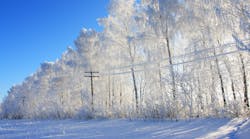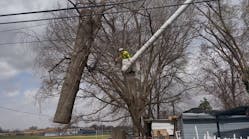How Data-Driven Vegetation Management Makes Rate Payer Dollars Go Further
Data-driven vegetation management planning is becoming increasingly necessary for electric utilities and regulators as they seek to improve the reliability and safety of their electrical infrastructure and minimize costs. “Tree contact with transmission lines is a leading cause of electric power outages and a common cause of past regional blackouts,” writes the US Federal Energy Regulatory Commission (FERC).
In the past, vegetation management has often been reactive, with utilities addressing tree-related outages and safety hazards on a fixed schedule or as they occurred. However, with the advent of new technologies and data analysis tools, it is now possible to take a proactive approach to vegetation management that is more effective and cost-efficient.
In short, regulators and utilities need to embrace data-driven, forward-looking planning and budgeting for vegetation management.
What Got us Here Won’t Get us There
There are many contributors to the current urgency for data-driven vegetation management. Advancing climate change has created more and fiercer weather, prompting floods, drought, and even tree disease. Expanding human development has increased the wildland-urban interface (WUI), exacerbating natural dangers. Researchers at the University of Colorado Boulder estimate 54% of Americans now live within 3 miles of a forest. What’s more, utility vegetation management (VM) teams suffer from real resource constraints as VM needs grow, prices escalate, and budgets stay flat. At the same time, as experienced VM managers reach retirement, the industry loses precious experience.
With the combination of these factors, environmental impact on the grid is more frequent and more destructive than ever. At the same time, utilities’ vegetation management teams are less able to respond, let alone proactively manage for these challenges.
It’s become clear that past practices are not today’s best practices. Many just don’t meet today’s industry reality of vegetation-management volumes and priorities. As many other industries have discovered, the ability to gather and process new sources of relevant data is the necessary, transformative evolution that will equip the utility industry to address these emerging challenges.
New VM Practices are Now Possible
Advances in data collection, computing, and analytics now allow for lower costs, more accuracy, and more expansive assessments of utilities’ ground truths. For example, new remote-sensing technologies, such as satellite imagery, are now inexpensive, demonstrably accurate, and impressively scalable compared to the time-honored methods. They are also greener and safer because they avoid sending crews and their work trucks into the field simply to observe vegetation growth.
The incredible volume and diversity of relevant data can now be applied to vegetation management, offering better predictions than ever of how current vegetation attributes correspond to immediate and future needs. With these technologies, today’s utilities can better understand the risks associated with vegetation near power lines and develop targeted strategies for managing those risks. For example, utilities can use data on weather patterns, soil types, and vegetation growth rates to predict which areas are most likely to experience tree-related outages and prioritize their vegetation management efforts accordingly.
Vegetation management forecasts that rely solely on past performance data – an outdated “best practice” – without also incorporating current data on actual field conditions, are no longer sufficient. With a proactive stance on vegetation management, utilities are already reducing the number and duration of power outages caused by trees and other vegetation. They are improving the reliability of their electrical grids and reducing the safety hazards of downed power lines. In addition, proactive vegetation management helps these forward-looking utilities prevent wildfires and other environmental damage caused by contact between trees and power lines.
How Data Aligns Utilities and Regulators on Budgets and Plans
Many regulators have accepted the common practice among utilities of time-based trimming cycles based on established patterns. This has maintained the budgeted VM work at relatively stable levels. However, in the last few years, due to inflation and rising contractor costs, traditional budgets are under more pressure. Utilities and regulators need to acknowledge that getting the same work done now costs more. At the same time, customer expectations for better reliability are also rising. The mounting pressures must be resolved, and the only effective solution is technology.
With these time-based practices, utilities also undertake vegetation management in parts of their territory that may not require as frequent trimming to comply with regulatory requirements. Vegetation growth is not uniform and local conditions always differ across a utility’s ROWs. Relying on calendar-based trimming is usually not the most prudent use of ratepayer dollars.
Transparent, data-driven processes provide more clarity between regulators and utilities. It lets them agree on the decision-making framework and underlying data and gives them more insight into how it’s managed. Tools like satellite-based inspection allow the utility to “show their work” and clearly lay out how priorities and work plans are developed. With increasing risks of natural disasters like wildfires and hurricanes, this is critical not only for demonstrating what work the utility thinks should be done and why, but also for justifying deferments the utility chooses to make.
How Does this Help Consumers?
In the long run, the legacy of time-based trimming cycles that are rooted in historical patterns ensures that roughly the same volume of work is done each year. But it does not ensure the most efficient use of budget to maintain reliability. In addition, doing that same volume of work becomes increasingly expensive as labor costs escalate.
By assessing only the work volume each year, the regulator is not necessarily ensuring the most important work is being done. This increases costs and reduces system reliability and service levels for the consumer. On the other hand, with a data-driven approach, VM priorities are clearly articulated and accurately budgeted, ensuring that the right spend focuses on the right jobs. Ultimately, it maximizes budget efficiency on the consumer’s behalf: Remote inspection followed by surgical vegetation management work is the most cost-effective process and significantly improves grid resilience.
Data-driven vegetation management planning also has the potential to be more cost-effective than reactive approaches. By using data to prioritize their vegetation management efforts, utilities can target the areas that are most at risk and avoid spending unnecessary resources on areas that are less likely to cause problems. This can lead to significant cost savings over time, particularly for large utilities with extensive infrastructure networks.
Data-driven vegetation management planning can help utilities engage with their customers and stakeholders in a more transparent and effective way. By sharing data and analysis results with the public, utilities can demonstrate their commitment to safety, reliability, and environmental stewardship. This can help to build trust and support among customers and other stakeholders, which can be important in an industry that is often subject to scrutiny and criticism.
Moving Forward
Data-driven vegetation management planning is an essential best practice for electric utilities. By using advanced analytics tools to develop targeted vegetation management strategies, utilities can improve the reliability and safety of their electrical infrastructure while minimizing costs and environmental impacts. This proactive approach to vegetation management has many benefits, including reducing the number and duration of power outages, preventing safety hazards and environmental damage, complying with regulatory requirements, and building trust with customers and stakeholders.
Abhishek Vinod Singh ([email protected]) is CEO and cofounder of AiDash. An alumnus of I.I.T. Kanpur, Abhishek worked with many IT companies prior to starting and growing a series of successful tech businesses including DbyDx Software & Edureka. He is based in Santa Clara, California.


